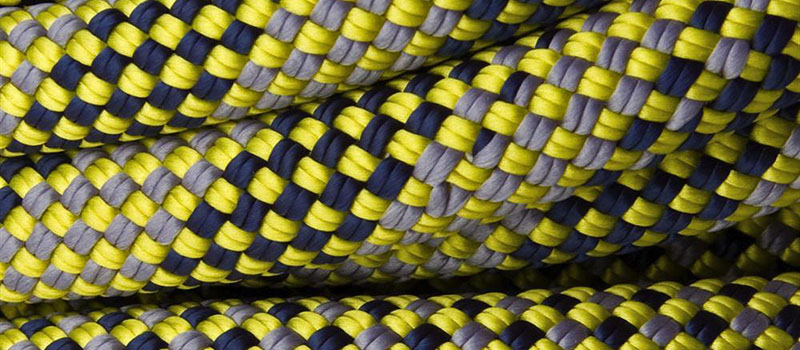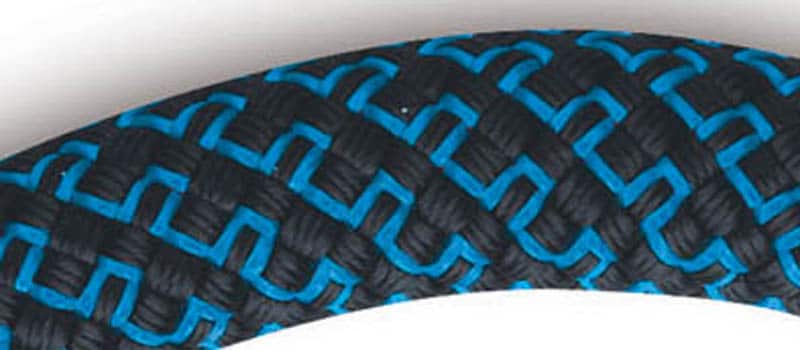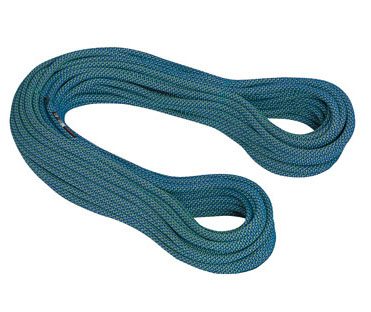The Mammut Finesse 9.3mm is one of the more unique climbing ropes on the market.
Look closely at your current rope’s sheath: almost certainly you’ll see a criss-crossing 2-strand x 2-strand braid pattern. Two strands overlap the other two strands.

If, however, you have a “twill pattern” rope—a distinguishing feature of many Maxim ropes—you’d see a 1×1 braid: which is just one strand overlapping another strand. I’ve long been a fan of twill-pattern ropes because their tight weave seems to lend itself to a long-lasting, durable rope. The usual critique you’ll hear about twill pattern ropes is they can be prone to kinking (though in my experience, many, especially those produced by Maxim, aren’t).
Probably 90 percent of climbing ropes on the market use a 2×2 braid.
The Mammut Finesse uses a 4×4 braid, which they call “Double Twist technology.” That’s 4 strands overlapping 4 strands.

What? That’s so cray!
Dude, I know! So cray!
To my knowledge, this is the only rope that uses a 4×4 construction. So … Is it any good?
One cool aspect of a 4×4 braid is that it provides an opportunity for a very unique pattern. Indeed, the Finesse rope is striking to look at. I got multiple comments from jealous friends commenting on how “cool” and “pretty” my rope is. Aw, shucks, guys!
I fell, lowered, winched, boinked, and occasionally sent real rock climbs on the Mammut Finesse 9.3 all summer. In general, I was really impressed with its durability. For being such a thin cord, the Finesse performs like rope that is much thicker in diameter. Ultimately, after 6 weeks of consistent use, a time came when I had to trim the rope ends due to wear and tear. In general, however, this rope is above average in terms of durability.
Funnily enough, the Finesse really does feel thicker than its purported 9.3mm diameter. I never actually measured the rope to fact check its claimed slender size (I know this makes me a lazy gear tester; whatevs). I just know within my seasoned hands, this rope feels much more like a 9.5mm or 9.6mm rope than a 9.3mm. Big deal? Not really. Either way, it’s more than thin enough to be considered a high-performance sport-climbing rope.
I really loved the Finesse for its great clipping performance. It has a nice handle and clipping draws is always quick and accurate.
The most distinguishing feature of the Finesse, however, is that I found it gives a pretty hard catch! This is no bungee cord, not by any means. It’s more like a cable. The purported elongation for the Finesse comes in at 30%. To put that in context, a static rope would be about 12%, while the maximum elongation allowed by the UIAA for dynamic ropes is 40%. I suspect that these properties have something to do with the Double Twist 4×4 braid pattern.
Here’s one way to look at it: you get a really durable thin rope, but the trade off is that, compared to other ropes of this diameter, the Finesse feels more static in climbing falls.
Knowing how to give a soft catch is really important when using this rope. I had to pay extra-special attention when I belayed my wife, who is 50 pounds lighter than me, in order to make sure that I gave her an appropriately soft catch. Even when she belayed me, I found myself coming into the wall a little hotter than usual due to the “cable-like” feeling of falling on this cord.
This isn’t necessarily a bad thing, however. In fact, there are many times when I appreciated these properties. Boinking up the Finesse to regain my high point was easier than it is with more elastic ropes.
The Finesse’s lower elongation also makes it really well suited to top-roping.
I’d highly recommend the Finesse to anyone who is looking for a durable, high-performance sport climbing rope in a thin, lightweight package. I’d especially recommend the rope if you’re a larger fellow looking for a thin rope. And, finally, if you also do a lot of top-roping. All in all, it’s a great all-around rope. Well priced. Durable. And most important, it’s pretty.
Really, it is.




Recent Comments